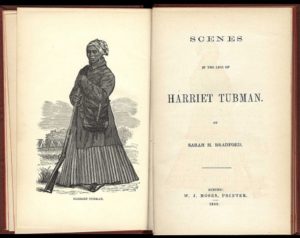Scarce Copy of Harriet Tubman Biography. Sarah H. Bradford’s 1869 book, the proceeds of which paid the mortgage on Tubman’s Auburn, New York home.
Harriet Tubman (1822-1913) was a fugitive slave, abolitionist, Union cook, nurse, armed scout and spy, a social reformer, and women’s rights activist. Her precognitive powers in avoiding capture were said to result from the traumatic head injury she sustained when a tidewater Maryland slaveholder hurled a measuring weight toward a young runaway she was shielding. It surely resulted in epilepsy, a condition Harriet lived with the rest of her life.
Self-liberating northward in 1849, Tubman became a conductor on the Underground Railroad, making thirteen trips back into the South to rescue some 300 slaves, including her parents, and not losing anyone. From 1858-on, and dubbed “General Tubman,” she used that same underground network to aid John Brown in planning and recruiting for his insurrection, and, during the Civil War in sourcing vital military intelligence behind enemy lines for the Union Army.
Among her innumerable exploits, in June 1863, she became the Civil War’s first woman to lead an armed assault during the Combahee River Raid in South Carolina, said to be the war’s greatest single military action liberating the most slaves, at over 750.
Resourceful, tough, and unyielding, Harriet’s generosity knew no bounds and she was fondly remembered for giving her last penny to anyone in need.


